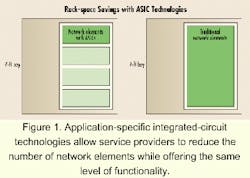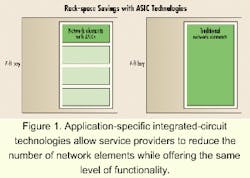ASIC application in next-generation network architectures
Custom ASIC technology provides significant benefits over non-ASIC solutions, especially in high-speed optical equipment.
MATHEW STEINBERG, Redback Networks Inc.
The amount of traffic on the public network is expected to grow by a factor of 25 times over the next five years. This growth is placing an incredible strain on the public network-and the carriers that operate it. Service providers must deploy equipment that lets them significantly increase network speed and capacity and, at the same time, reduce operational costs. New scale and feature requirements cannot be met without powerful technology enhancements. Incremental enhancements and network overlays will not suffice.
To meet the demands of end users and service providers, a new set of capabilities must arise to dramatically increase network-processing power, functional integration, end-user service tunability and customization, and rapid dynamic provisioning. Today's networks are incapable of scaling to meet the forecast growth in capacity, nor can these infrastructures deliver the variety of new services desired by end users.Application-specific integrated-circuit (ASIC) technology can be an important element in creating a dense, powerful network architecture that can scale to 25 times and beyond. It is also an excellent way to provide the processing power necessary to deliver rapid provisioning and intelligent service routing. The application of newly emerging ASIC technology is needed to go beyond the forwarding of packets at full line rate as today's carrier core Internet-protocol (IP) routers do and to be able to process packets in the context of new IP services.
Why aren't more companies embracing ASICs? The reason lies in evaluating the risk-versus-reward tradeoff. Taking the non-ASIC approach fundamentally lowers the risk. An ASIC is a chip that is customized, or built from the ground up, for a specific application. A field-programmable gate array (FPGA), in contrast, is a general-purpose chip that can be programmed, and reprogrammed, to perform different tasks. FPGAs and merchant-market silicon allow vendors to bring product to market faster (it can take 12 to 18 months to develop an ASIC), and for less up-front investment. However, ASICs allow vendors to build faster, smaller, more power-efficient products. Moreover, when it is leveraged in high-speed optical equipment, custom ASIC technology can provide significant benefits in performance, functionality, and service delivery.
ASIC-based designs excel in performance and density, especially for optical platforms. For high-speed optical equipment targeted at carrier networks, ASICs give equipment vendors the ability to provide offerings with features not available by integrating merchant silicon and FPGAs into a system. While it's possible to add capability and features to merchant silicon by augmenting the design with custom-designed FPGAs, the limitations of FPGA technology constrain the designers' ability to provide the maximum feature set.
Getting an exact comparison between ASICs and FPGAs on the basis of performance is tricky. There are ways to get an idea of the difference, however. One method of comparison is to evaluate the operating frequencies supported by the two technologies. Current ASIC complementary metal-oxide semiconductor (CMOS) technology routinely supports clock rates of 200 MHz. The closest that FPGAs get is about 100 MHz-very suitable for the speeds associated with many types of traditional edge aggregation. The ASIC-based performance gains, however, are critical for the high speeds utilized in evolving optical-access networks.
Another useful benchmark is the number of usable gates (the number of gates actually used to perform a function), which gives a good indication of the level of functionality supported-the higher the number, the greater the processing power, the more features each chip can support. Today, the most advanced FPGAs contain about 600,000 usable gates. High-end ASICs can hold up to 10 times more. This trend is expected to continue.
The increased density offered by ASICs is also a key advantage. For large exchange carriers and competitive local-exchange carriers (CLECs), floor space is becoming an expensive commodity. An ASIC product that is four times as dense as the prior generation of technology will occupy one quarter of the space (see Figure 1). If it costs $500 per rack every month and a solution is reduced from four racks to one, the service provider will save $1,500 per month per site. Over one year, that amounts to $18,000 for each site. In a network that contains hundreds or perhaps thousands of sites, the savings are considerable. The payback period on the ASIC-based technology, in some cases, can be as short as a little over a year.
The ability to integrate technologies in a single chip is one of the key attributes of ASICs. This flexibility allows the consolidation of multiple network elements into a single unit. For service providers, fewer network elements can dramatically reduce costs (such as sparing) and floor-space requirements. Installation is faster since fewer network elements need to be set up and provisioned. The increased functionality can also result in significant lifecycle cost savings as end-to-end management and provisioning improves, in part because disparate management systems are eliminated. Additionally, a reduction in the number of network elements further allows the service provider to dramatically improve sparing costs.
As service providers scale their networks, power consumption is becoming more of an issue. ASICs help decrease aggregate power consumption in two distinct ways: by the overall reduction of network elements and through the "tuning" of ASIC designs to reduce power consumption. One example is by using slower gates or transistors for less critical signals.FPGAs, on the other hand, must be built throughout with elements that have been designed into the FPGA prior to any knowledge of its functional requirements. To provide the flexibility required by an FPGA, each gate is not optimally designed for the task chosen for it, but for a generic task. The result is lower efficiency and, therefore, much higher power dissipation to perform a given function.
ASICs have an additional advantage over FPGAs when optimizing the implementation of a specific function. Since ASICs are built from scratch, a larger pallet of building blocks can be offered to the designer. The effect of higher power consumption is that it increases the overall system cost by forcing designers to install larger power supplies as well as expensive cooling systems to deal with heat generation. The consolidation of multiple network elements combined with the effect of tuned ASIC designs can result in significant power savings as illustrated in Figure 2. Lower power consumption reduces a carrier's operational costs, especially when the power savings is accumulated over thousands of network elements and hundreds of facilities.
The ability to provide dynamic services to subscribers is a key differentiating factor for service providers. Today's static service model focuses on connectivity, is difficult to provision, offers few commodity services, and is people intensive. The dynamic model, in contrast, will empower broadband subscribers with rapid and dynamic auto-registration, personalized service selection, secure service delivery, and real-time billing.
Embedding this functionality in ASICs can dramatically reduce incremental delivery costs since the "hooks" for new features are resident in the service platform. Service activation does not require incremental truck rolls or upgrades of new modules, cards, or software.
Numerous software architectures are being built into proposed next-generation network platforms. The software used in any given product is dependent on the ASIC architecture. With non-programmable ASICs, most of the processing is done in hardware (i.e., in the ASIC) and is not a programmable-software component. With programmable ASICs, the packet processing is done in software that runs on the ASICs. Both the platform vendor and the service provider can achieve flexibility and rapid reconfigurability by customizing the packet processing through software as opposed to using new hardware and software to deliver new services. This capability is a key requirement of dynamic subscriber services. Unique ASIC designs allow this functionality without a reduction in performance.
The technology used to create the new access network and its corresponding building blocks is critical. ASIC technology is an excellent way to provide the processing power necessary to deliver rapid provisioning and intelligent service routing. Companies developing next-generation optical solutions can differentiate their products by creating powerful new ASICs and placing this technology in the heart of their equipment.
Mathew Steinberg is director of marketing at Redback Networks Inc. (Sunnyvale, CA).


